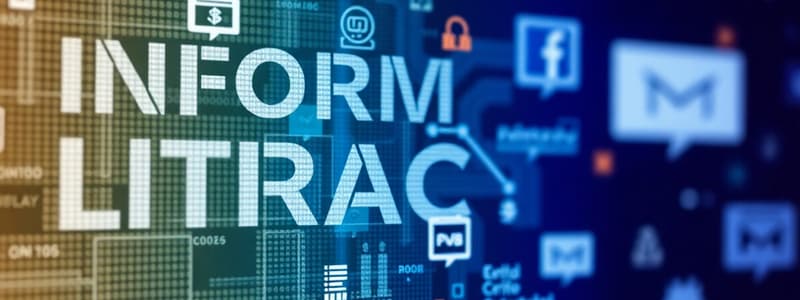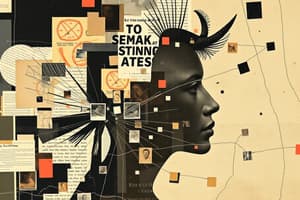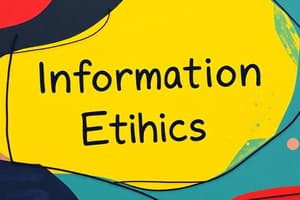Podcast
Questions and Answers
What is the primary focus of media language in the context of language studies?
What is the primary focus of media language in the context of language studies?
- The history of media development
- The influence of social media on communication
- The structure of the English language
- Technical and symbolic ingredients used in media (correct)
Which of the following is NOT a reason why linguists are interested in media?
Which of the following is NOT a reason why linguists are interested in media?
- Media can shape political discourse
- Media often consists of complex grammatical structures (correct)
- Media contributes significantly to language exposure
- Media serves as a major linguistic institution
How do media codes and conventions function in media communication?
How do media codes and conventions function in media communication?
- They only apply to television broadcasting
- They are random and have no significant meaning
- They form consistent meanings and expectations for the audience (correct)
- They provide a misleading representation of reality
What does the technical code of camerawork primarily involve?
What does the technical code of camerawork primarily involve?
Which element is considered a technical code in media language?
Which element is considered a technical code in media language?
Which aspect is NOT typically included in the lighting technical code?
Which aspect is NOT typically included in the lighting technical code?
In the context of media literacy, what do conventions primarily refer to?
In the context of media literacy, what do conventions primarily refer to?
What is the primary function of editing as a technical code?
What is the primary function of editing as a technical code?
Why might media serve as a valuable source for second language learners?
Why might media serve as a valuable source for second language learners?
What does the term 'media discourse' contribute to its society?
What does the term 'media discourse' contribute to its society?
Which of the following describes the written codes in media products?
Which of the following describes the written codes in media products?
Which of the following is a characteristic of media language as described by linguists?
Which of the following is a characteristic of media language as described by linguists?
What is the role of conventions in media products?
What is the role of conventions in media products?
What does 'form convention' primarily pertain to?
What does 'form convention' primarily pertain to?
What is a common expectation for the arrangement of media codes in a film?
What is a common expectation for the arrangement of media codes in a film?
What is NOT an aspect of editing as a technical code?
What is NOT an aspect of editing as a technical code?
What does the symbolic code of acting primarily refer to?
What does the symbolic code of acting primarily refer to?
How does the setting as a symbolic code function in a narrative?
How does the setting as a symbolic code function in a narrative?
Which component of mise en scene is not included in its definition?
Which component of mise en scene is not included in its definition?
What role does color play as a symbolic code in media?
What role does color play as a symbolic code in media?
What distinguishes technical codes from symbolic codes in media?
What distinguishes technical codes from symbolic codes in media?
What are diegetic sounds in film?
What are diegetic sounds in film?
Which of the following best describes symbolic codes?
Which of the following best describes symbolic codes?
What aspect of audio codes primarily deals with sounds generated by sources outside the story's context?
What aspect of audio codes primarily deals with sounds generated by sources outside the story's context?
What action constitutes plagiarism according to the provided information?
What action constitutes plagiarism according to the provided information?
How is plagiarism distinct from copyright infringement?
How is plagiarism distinct from copyright infringement?
What is a recommended method to avoid plagiarism?
What is a recommended method to avoid plagiarism?
Which of the following actions is NOT considered plagiarism?
Which of the following actions is NOT considered plagiarism?
What does the term 'Netiquette' refer to?
What does the term 'Netiquette' refer to?
What does inadequate acknowledgment involve?
What does inadequate acknowledgment involve?
Which of the following statements is true regarding plagiarism?
Which of the following statements is true regarding plagiarism?
Which of these practices is advisable to prevent plagiarism?
Which of these practices is advisable to prevent plagiarism?
What is a key principle of online behavior, according to the guidelines for netiquette?
What is a key principle of online behavior, according to the guidelines for netiquette?
What does the digital divide refer to?
What does the digital divide refer to?
What is considered bad practice in online communication according to netiquette?
What is considered bad practice in online communication according to netiquette?
Which of the following is a reason proponents state for closing the digital divide?
Which of the following is a reason proponents state for closing the digital divide?
What should individuals do before participating in a new online community?
What should individuals do before participating in a new online community?
Which characteristic defines internet addiction?
Which characteristic defines internet addiction?
What is a common misconception about netiquette?
What is a common misconception about netiquette?
Which of the following is advised for maintaining healthy online interactions?
Which of the following is advised for maintaining healthy online interactions?
Flashcards are hidden until you start studying
Study Notes
Media and Information Literacy
- Students will learn to evaluate media and information by understanding codes, conventions, and messages in relation to audience and producers.
- They will also produce and assess group presentations using similar frameworks.
Understanding Language in Media
- Language encompasses symbolic ingredients and technical codes that professionals select for communication.
- Technical codes include sound, camera angles, shot types, and lighting, guiding the audience’s interpretation of media.
Importance of Media Language
- Media serves as a vital linguistic resource for research and teaching by providing rich data.
- It significantly contributes to the language learners are exposed to and often serves as a primary model for native speakers.
- Media is a social institution that presents culture, politics, and societal narratives.
Codes and Conventions in Media
- Media codes function as the foundational elements that create meaning, helping audiences decode communication (e.g., emojis, slang).
- Conventions are established expectations concerning how these codes are arranged for effective storytelling.
Symbolic Codes
- Symbolic Codes: Elements that relate to real-life situations, enhancing audience connection (e.g., emotional reactions depicted in characters).
- Setting: Indicates the time and place of the media's narrative, which can vary in scale and realism.
- Mise en Scene: Refers to all visual elements within the frame, including set design, costumes, and composition.
- Acting: Involves the portrayal of characters through expressions and body language to drive narrative and tension.
- Color: Has strong cultural significance, with specific colors used symbolically to convey messages.
Technical Codes
- Audio: Distinguishes between diegetic sounds (originating from within the story) and non-diegetic sounds (external commentary or music).
- Camerawork: Focuses on camera movement and positioning to create effects and meaning.
- Editing: Involves arranging and manipulating visual and audio elements to enhance storytelling.
- Lighting: Uses various lighting techniques to highlight elements, creating mood and atmosphere.
- Written Codes: Employs formal language for narratives and themes, including subtitles and credits.
Conventions of Media
- Conventions guide audience expectations in media presentations (e.g., structure of films and news articles).
- Form Convention: Specific arrangements that audiences anticipate (e.g., movie titles, newspaper layouts).
- Narrative Convention: Traditional structures for storytelling that professionals rely on.
Plagiarism
- Defined as failing to credit original sources through:
- Copying text without citation.
- Paraphrasing without acknowledgment.
- Altering structure without credit.
- Claiming originality through minimal word replacement.
- Inadequate citation practices.
- Important to differentiate between plagiarism (misappropriation of authorship) and copyright infringement (unauthorized use of material).
- To avoid plagiarism, maintain originality, seek permission for substantial use, and always cite sources properly.
Netiquette
- Refers to acceptable online behaviors governing communications in digital interactions.
- Core principles include treating others as people, adhering to ethical standards, and being culturally aware.
- Additional guidelines involve maintaining an online reputation, sharing knowledge, and respecting privacy.
Digital Divide
- Describes the gap between demographics that have access to technology and those that do not, affecting literacy and social mobility.
- Recognized as a current concern, with advocates arguing for access to technology as a human right necessary for societal improvement.
Internet Addiction
- Represents compulsive online behavior that negatively impacts relationships, work, and health, involving games, social interactions, and access to information.
Studying That Suits You
Use AI to generate personalized quizzes and flashcards to suit your learning preferences.




